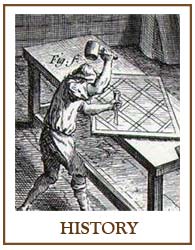Australian Sash Windows
See this article for information on the origin of sash windows in Britain
All window glass was imported into Australia until a domestic sheet glass trade was established in the 1930s. Early examples of Australian Figured Rolled Glass can be found in our Pattern Glass ID Guide.
Colonial Windows
A First Fleet of British ships arrived at Botany Bay in January 1788 to establish a penal colony in Sydney. Consequently the earliest Australian architectural style copied the Georgian styles from Britain and has become known as Colonial architecture.
Buildings erected in the early years of Australian settlement were simple, plain and functional. As glass manufacturing was still expensive, and limited to producing smaller panes of cylinder glass, often windows were only shuttered. Glazed windows were generally small with multiple panes of in a grid pattern. Using narrow astragal glazing bars, to connect the panes. allowed for larger window sashes. These are often referred to as ‘Colonial bars’ or ‘Georgian bars’.
As the Australian economy developed and settlements became more established more elaborate buildings emerged in the Old Gothic and Regency styles.
Victorian Sash Windows
During the reign of Queen Victoria British migration increased and settlers in the colonies were able to utilise the latest and most fashionable advancements in Victorian architecture. Public buildings, across all the colonies, were routinely designed in Britain by prominent architects of the time.
First appearing around 1830, the group of styles collectively referred to as Victorian architecture is a series of revival styles. With so many different styles arising during the reign of Queen Victoria, it may begin to seem as though these are all different architectural styles. Sash windows, columns, bay windows, turrets, dormers, cornices, and gables are the common theme.
Victorian Gothic revival
The Gothic style became widespread in the 19th century, characterised by its ornate stone and brick structures. Victorian Gothic architecture was lavished with ornamentation and decoration. Victorian sash windows incorporated curved horns, arched heads, intricate mouldings, lead-lights and latticework adorned the sashes. Windows were often grouped into impressive bays, offset with ornate stone reveals. Graduating the size of windows from the ground upwards not only improved the perspective but also increased the amount of light to the lower rooms.
Late Victorian
The Industrial Revolution brought many technological advancements, including the manufacture of larger panes of glass. Window styles from this period were simpler, typically featuring either single panes or two over two vertical split glazing pattern. The bull-nose veranda roof started to appear, timber fretwork became common and sidelights were added beside front doors.
Filigree / Italianate
A prominent feature of Australian architecture is the wrought iron filigree balcony often termed ‘iron-lace’. Many homes constructed during the 1870’s and the 1880’s were two storey Victorian Filigree terraces. Filigree also became a popular adornment for gates, veranda’s and doorways.
Federation Windows
1890 – 1915 Australian colonies collectively became the Commonwealth of Australia in 1901. Since the late 60’s Australia has adopted the term ‘Federation Architecture’ to reference the late Victorian and Edwardian eras of architecture. Whilst Federation architecture is very similar to the British Edwardian era, regional influences do set it apart. Federation style borrowed freely from the eras that preceded it, combining the best features of the Georgian and Victorian styles whilst incorporating the newer Filgree and Arts and Crafts influences.
By the early 1900’s, side hinged casement windows became increasingly popular. A popular style for the casement window was to be grouped into a bow window featuring a decorative Art Nouveau or Neo-Georgian lead-lights in the upper section. It was not uncommon to have casement window frames and double hung windows located in the same house. Double hung sash windows often incorporated a six over two glazing configuration. Fanlights and coloured glass became common features in sidelights and above doors.
Federation Queen Anne (Queen Anne revival)
Queen Anne style was a revived form of English Baroque architectural styles and is considered to span 1880–1900, although the popular style persisted for another decade. This style typifies most peoples idea of a Federation building. Dark brick gables with tuck pointing, white-painted window frames and large verandas.
The Queen Ann sash window with a single pane to the bottom sash and multi-panes to the upper sash is a classic design. More elaborate windows featured sashes with stained or coloured glass. Sash window/door hybrids, where the window continues to the ground, allowed access to a homes veranda’s became popular.
Anglo-Dutch
Adopting much from the Queen Ann style, Anglo-Dutch is characterised by the plain red-brown brickwork of their facades and the stepped or scalloped dutch gables in their roofs. Windows are typically of the Queen Ann style; double-hung and painted white.
Other Australian Architecture
Queenslander (Federation Filigree)
Queenslander architecture is a modern term for the typical residential architecture of Queensland, Australia. The characteristic trait of these timber homes, built on stumps, is a veranda that extends around the house to varying extents. Alignment of doors and windows to allow uninterrupted air flow helped to cool living areas. The Queenslander has been constructed in all the popular styles of the time, including Colonial, Victorian, Federation, Art Nouveau, Interwar styles, and post-World War II styles. Queenslanders are still constructed today using modern styles, as well as “reproductions” of previous styles.
Bungalows
First introduced to Sydney in 1906 the American California Bungalow style was usually a single-storey house with the roof covering a prominent veranda. Timber casement windows were most frequently used on the frontage. The Federation Bungalow style was the Australian response to the American Bungalow styles. It can be regarded as a transition between Federation Queen Ann and the American Bungalow. Tuck pointed brick work, ornamental veranda’s and multi-paned timber casement windows with lead-lights featuring Australian fauna and flora.
Sash Window Specialist Blog UK & AU
Visit our main blog at sashwindowspecialist.com for more articles & our work portfolio.
Click Here

